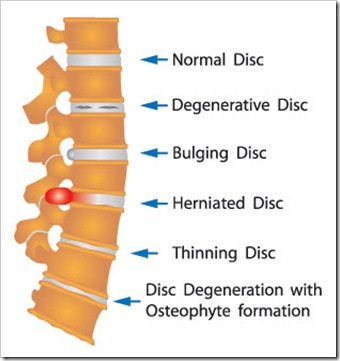
The American lifestyle over the last few decades has given rise to today’s leading cause of infirmity. Unfortunately, lower back pain is so common that it affects almost 90% of adults. The majority also suffer from lumbar arthritis as a contributing factor to their lower back pain. Spinal arthritis is a degenerative process that develops over time in response to the stresses placed on the spinal joints. Spinal arthritis can cause symptoms from mild to severe back pain as well as spinal stiffness.
Understanding Your Spine
The spine is composed of twenty-four moving segments, known as vertebrae, classified into three regions: cervical (neck), thoracic (mid-back), and lumbar (lower back). Between the spinal vertebrae are intervertebral discs composed of an outer ligamentous layer (annulus fibrosis) and a central gelatinous layer (nucleus pulposis). The discs are anchored to the vertebrae by the collagen fibers of the annulus fibrosis; allowing movement between vertebrae and the distribution of weight bearing forces from one vertebra to the next in the spine.
The intervertebral discs often lose their elasticity and hydration with age or as the result of an injury. The loss of elasticity decreases their ability to handle all the load bearing forces of daily activity. When the discs thin, this changes the relative position of the vertebrae and the connective tissues throughout the rest of the spine. Over time, this thinning of the disc could progress to where the vertebra is effectively lying on the next vertebra. The loss of disc space often results in increased pain and decreased ranges of motion.
Ultimately, this pattern of degeneration can lead to microfractures and cartilage injury. Although the body tries to replace and repair the damage, it is often insufficient to overcome the degenerative process on without assistance.
As the joint surface erodes there is an increase in mechanical stress on all the joints of the spine. The body’s natural response to this stress is the formation of new bony outgrowths called osteophytes. In the spine, this process is commonly found in the facet joints and on the edge of the vertebral bodies of the lumbar spine. If combined with compression, bulging discs, and hypertrophy of spinal ligaments then the size of the spinal canal may decrease causing spinal stenosis. Compression or injury to the spinal cord and nerves can occur with spinal stenosis.
What Are The Symptoms?
The classic symptomatology of arthritis includes joint pain, swelling, and stiffness. Lumbar arthritis often results in lower back or pelvic pain. Arthritis sufferers may have difficulty with mobility secondary to postural changes and decreased flexibility.
As with most forms of osteoarthritis, pain and stiffness are the most pronounced symptoms in the morning. As movement increases over the course of the day, the symptoms tend to subside. In general, if there is no evidence of nerve root compromise, pain from an arthritic spine is localized to the low back with possible dull aching and referred pain in the buttocks.
Patients with degenerative changes resulting in spinal stenosis may experience numbness, tingling, or weakness in the legs due to irritation of the lumbar nerve roots.
How is Arthritis in the Lumbar Spine Diagnosed?
A chiropractic physician can make the diagnosis of lumbar arthritis when the variety of symptoms and physical exam are consistent with degenerative changes in the spine.
For instance, a description of back pain for an extended period of time that increases with mechanical stress may alert your doctor to the presence of lumbar arthritis. Therefore, it is important to provide your chiropractic physician with detailed information about your back pain including timing, severity, and exacerbating or alleviating factors.
The physical exam will focus on the range of motion within your spine, muscle strength, and reflexes within your legs. Patients with lumbar arthritis will notice pain when bending backward because this places maximal pressure on the osteoarthritic facet joints. Likewise, patients may find that the pain decreases when bending forward because this relieves joint pressure.
An X-ray will likely be ordered to be able to have a detailed look at the bones that make up the lumbar spine. Specifically, your chiropractic physician will look for new bone growth (osteophyte formation) and the narrowing of the intervertebral disc space. If a more detailed look is necessary, a CT (computed topography) or an MRI (magnetic resonance imaging)-may be ordered.
What Treatment Options Are Available?
Lumbar arthritis is usually responsive to conservative management.
During an acute attack of low back pain, relative rest that avoids activities that aggravate the symptoms may reduce inflammation. Drinking moderate amounts of water frequently while minimizing caffeinated drinks will also be beneficial in helping hydrate the discs.
For long term relief, lifestyle modification must be undertaken. This includes weight loss when appropriate as it will have a tremendous impact on reducing back pain due to the lumbar spine bearing the weight of the upper body and weight of the head.
Exercise is also critical as it will contribute to reducing weight while increasing muscle strength to support the lower back. You should consult your chiropractic physician before beginning any exercise or diet program.
Your chiropractor and their spinal rehabilitation team may prescribe spinal decompression in combination with rehabilitative therapy. Working the rehabilitative team to design a proper exercise regimen will be useful for strengthening core muscles and minimizing your back pain.
We Can Help!
Our team understands that long-term back pain is not only physically debilitating but emotionally exhausting. To serve our community, we have built an expert team committed to working together harmoniously to help you or your loved ones recapture the quality of life they desire – pain-free!
For Your Health,
Dr. Robert Ringston
